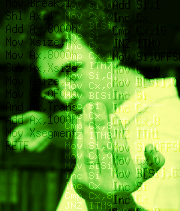I just went into a super video (link below) about how collision code can be exploited in Super Mario World to beat the game faster. I'm not much into speedrunning myself, but I love whatever can teach us how those old games where built and what is the logic behind their engine. And tool-assisted speedrunning quickly gets quite deep into those subjects. So let's go.
C'est du tout bon. Une vraie pépite. Une fois encore, "retro-game mechanics explained" confirme que même quand on a pas l'intention de pratiquer le speed-run intensif, les découvertes des speedrunners sont une mine d'or pour qui s'intéresse aux techniques de programmation utilisées par les anciens de l'ère 8/16-bit. Et cette fois, c'est Super Mario world qui s'y colle.
 When a tile is activated, it is deleted, and a sprite version of the block will displayed in its place. When that sprite returns to its initial position, it is removed, and another tile is set in its place (usually a brown block).
When a tile is activated, it is deleted, and a sprite version of the block will displayed in its place. When that sprite returns to its initial position, it is removed, and another tile is set in its place (usually a brown block).
Well, that was an expected one. And as he explains, it was already used in SMB3 (and probably also back in SMB1). It is something I'd like to put into my own game engine as well, although the closest I have so far is simply the "mapanim" to replace tiles of a specific location on the map along an animation triggered by a collision.
Si vous avez déjà un peu cogité la manière dont les consoles nintendo construisaient leurs images à base de mosaïques de "tiles" et des "sprites" par-dessus, vous aurez aussi deviné que pour faire sursauter un bloc-question quand on le touche, il faut effacer le bloc de décor (à base de tiles, donc) et le remplacer par un graphisme librement positionnable (un sprite) le temps de son sursaut, puis remettre à nouveau des tiles pour le bloc transformé. C'est sympa d'en avoir une confirmation depuis l'analyse du code (et oui, j'ajouterai ça dans ma todoux-liste un de ces quatres).
The next one is a bit more unexpected.
 Which tile is activated during sprite/tile collision is determined by a point that is a mix (blue) between the the sprite's position (green) and its clipping box (red). If that point is not within the tile that was activated [...] there will be block duplication.
Which tile is activated during sprite/tile collision is determined by a point that is a mix (blue) between the the sprite's position (green) and its clipping box (red). If that point is not within the tile that was activated [...] there will be block duplication.
Of course, that duplication is the whole point in SMW - Level End Glitches video by RG Mech EX: the location where to spawn the bopping block and set the new brown block won't match the original question block location, which will remain unchanged. Interrestingly, this is partly because sprites that are located inside a solid tile are ejected outwards so that they don't get stuck. I always thought that would be mario-specific, but actually no: it applies to all objects.
Un peu plus inattendu: en plus de leur zone active -- la hitbox, en rouge sur la carapace -- qui doit rester en-dehors des zones solides du jeu, les objets ont un point unique qui sert à déterminer quel bloc a été touché. Si on cogne un bloc-question avec une carapace lancée vers le haut, c'est d'abord le carré rouge qui va renseigner qu'il y a collision puis le point bleu servira à trouver avec quoi il y a collision. Chose intéressante, tous les objets subissent le traitement "repoussé par les murs" qui autorise Mario à contourner un bloc lors d'un saut plutôt que de s'y cogner méchamment
comme une Giana sister.
En revanche, le fait d'avoir mis le point-test en dehors de la zone de collision m'intrigue. Quelle est la raison ? ou est-ce juste un bug ? et cette possibilité d'avoir changé de position entre les deux opérations du test de collision (boîte et point) trahit-elle une optimisation du genre "on ne teste les blocs-question qu'une frame sur 4" ?
A few wonders ...
- is there a good reason for that blue hot spot not being with the red box (other than saving computation cycles) ? It just sounds like a bug to my ears, since the red box is what triggers the collision.
- is that "ejected first but still triggering the initial block" linked to some lower rate for the collision code compared to the motion code ?
And did you know ?
 In order to reduce the number of distinct objects, some power-up blocks have different contents depending on their X coordinate on screen.
In order to reduce the number of distinct objects, some power-up blocks have different contents depending on their X coordinate on screen.
The limit on the number of objects you can have in a game engine is a old opponent. I know him a bit too well myself. But still ... Thinking of editing your level and having to shift that key pick-up one block to the left or one to the right so that it actually contains a key feels just mind-blowing. Naturally, it might not have been a big deal for Miyamoto's team who already knew player needs wide enough areas to move their avatar around ... and possibly went for "aha! guess which of those 4 ?-blocks hold a key and which are mere coins ;-)". But still. That's pretty unexpected.
Mais il reste le plus croustillant. Le truc que explique qu'un bloc supposé contenir une clé peut tout d'un coup donner des ailes à yoshi. Visiblement, je ne suis pas le seul à avoir choisi trop peu d'information par bloc dans mon format de niveau, et pour pouvoir représenter tous les power-ups et bonus possibles dans Super Mario World, l'équipe de Myamoto a choisi d'utiliser la
position du bloc au sein du niveau pour choisir quel objet serait offert au joueur. Pas la position absolue, hein, mais le fait qu'il soit sur un bloc pair, multiple de 4, impair, etc.
C'est à la fois génial et complètement déroutant. Dans un commander keen, je ne me serais jamais attendu à un truc du genre "si le bonus est au 2eme étage du building, alors c'est une glace à 2000 points. S'il est au 1er c'est un donuts à 1000 points et au 3eme un nounours à 5000". Mais ici, dans un contexte où les blocs-question sont souvents présentés alignés comme les gobelets d'un jeu de hasard, le truc prend tout son sens. Il reste à considérer le "numéro" stocké dans le niveau non plus comme un identifiant
d'objet à créer mais plutôt comme l'identifiant du
générateur d'objets correspondant. Au moins, ils ont évité les contraintes du genre "un niveau peut offrir soit les ailes, soit une clé, soit un ballon, mais jamais une combinaison de ceux-ci."









 Vote for your favourite post
Vote for your favourite post


